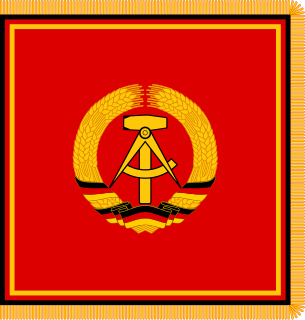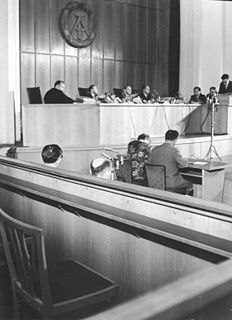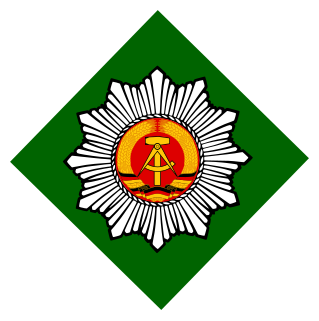 W
WThe Constitution of East Germany refers to the constitution of the German Democratic Republic, commonly known as East Germany. Its original constitution was promulgated on 7 October 1949. It was heavily based on the "Weimarer Reichsverfassung", such that the GDR would be a federal and democratic republic. In 1968 the East German government adopted a new constitution that was based on Marxism-Leninism, political unitarism, and collective leadership. There were further amendments to the 1968 constitution in 1974. With the political events of 1989, there were attempts to draft a new constitution for East Germany, but these efforts never materialized due to the dissolution of East Germany and the accession of its Lander into the neighboring Federal Republic.
 W
WThe cabinet of Lothar de Maizière was the last cabinet of East Germany before German reunification and the only democratically elected government of the German Democratic Republic. It was formed on 12 April 1990, following the general election in March, and existed until reunification with West Germany on 3 October 1990.
 W
WThe East German passport was issued to citizens of the former German Democratic Republic for international travel. Since the reunification of Germany in October 1990, all German citizens have been issued German passports.
 W
WThe Volkspolizei served as the armed forces and the national police of the German Democratic Republic from 1946 to 1956. The Volkspolizei was responsible for most law enforcement in East Germany, but because of its organisation and structure it was also considered a paramilitary force. Unlike police forces in most countries, they were equipped with armored personnel carriers and artillery and trained as military units.
 W
WThe Main Administration Sea Police was an East German maritime organization established with support of the Soviet Navy on June 16, 1950. It was an armed organization of the East German Ministry of the Interior designed to protect the German Democratic Republic’s (GDR) maritime border and coastal areas. The HVS was established to organize, train and operate naval forces during a period in which East Germany officially had no military. The Sea Police initially were responsible for protection of fisheries and for anti-smuggling activities. At the same time it was intended from the beginning to use the force as the core of a future East German navy. One of the first tasks of the Sea Police was the clearance of mines in the coastal waters of the GDR.
 W
WThe Majakowskiring is an ellipse-shaped street in the Pankow district of Berlin, Germany, in the Niederschönhausen locality. It was famous as the residence of many senior figures in the government of the German Democratic Republic.
 W
WThe Modrow government refers to the final socialist government of the German Democratic Republic (GDR), which was led by Socialist Unity Party (SED) official Hans Modrow from November 1989 until East Germany's first democratically elected government took power on 18 March 1990.
 W
WThe president of the German Democratic Republic was the head of state of the German Democratic Republic, commonly known as East Germany, from 1949 until 1960. The office was created by the Constitution of 1949. The president of the Republic was elected by the People's Chamber (Volkskammer) and the Chamber of States (Landerkammer), the two chambers of parliament. The office was mostly ceremonial in nature. If necessary, the President of the Volkskammer acted as the president of the Republic.
 W
WThe State Council of East Germany was the collective head of state of the German Democratic Republic from 1960 to 1990.
 W
WThe Supreme Court of the German Democratic Republic was the highest judicial organ of the GDR. It was set up in 1949 and was housed on Scharnhorststraße 6 in Berlin. The building now houses the district court in Berlin, Germany 2 Instance and the District Court Berlin-Mitte. In the early days, 14 judges made up the court.
 W
WThe Volkskammer was the unicameral legislature of the German Democratic Republic.
 W
WThe Deutsche Volkspolizei, commonly known as the Volkspolizei or VoPo, was the national police force of the German Democratic Republic from 1945 to 1990. The Volkspolizei was a highly-centralized agency responsible for most civilian law enforcement in East Germany, maintaining 257,500 personnel at its peak. It was part of the Armed organs of the GDR.
 W
WThe Volkspolizei-Bereitschaften were paramilitary police units of the German Democratic Republic from 1955 to 1990. The VPB were barracked units of the Volkspolizei for riot control and counterinsurgency with regiment status, under control of the Ministry of the Interior and considered part of the armed forces, but were never part of the National People's Army or the Ministry of National Defence. The VPB were organized as Internal Troops like in many Warsaw Pact countries. The VPB functioned as the de facto armed branch of the Ministry for State Security (Stasi), the secret police force of the German Democratic Republic, although this ministry had its own military unit, the "Felix Dzerzhinsky Guards Regiment" as well.